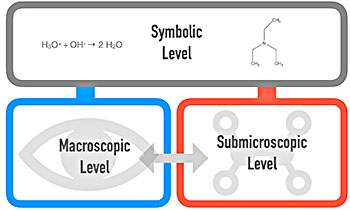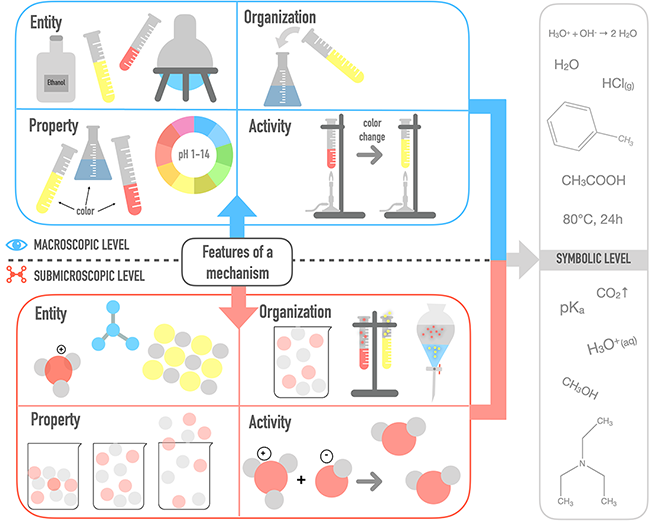Prozessbetrachtung im organisch-chemischen Praktikum
Abgeschlossenes Projekt
From the visible phenomenon to the chemical process - Linking the macroscopic and the submicroscopic level in the organic chemistry lab course
(Mitarbeiterin: Liz Keiner)
Understanding chemistry often relies on making sense of the invisible and the untouchable [1-6]. One of the reasons for the difficulties that students experience in understanding the nature of matter is related to the multiple levels of representations described by Johnstone [3]. These levels are used in chemistry to describe and explain chemical phenomena and help the learners to differentiate their reasoning into observations (macroscopic level) and submicroscopic considerations of chemical phenomena. Especially in organic lectures submicroscopic considerations and symbolic representations dominate but often there is no conscious change between these levels. In the laboratory, the levels of representation must be connected in a meaningful way, which often causes major problems for students.[3, 6, 7].
Several studies suggest that in order to develop a robust understanding of foundational chemistry concepts, students must be able to connect their observations with the submicroscopic and symbolic level [7-10].
One opportunity to explicitly integrate and connect these levels is trough practical lab work [11]. This allows linking the theoretical concepts learned during lecture with macroscopic observations during observing the reaction. However, linking the macroscopic and the submicroscopic level while working in the lab represents a huge challenge for the students. They may not be aware of how submicroscopic consideration can either help in planning and monitoring the synthesis or trouble-shooting when problems occur.
The overarching goal of this project is to develop instructional strategies that guide students in the organic lab to consider and connect macroscopic observations with submicroscopic considerations of the ongoing chemical processes. Literature so far provides limited information on how students use and link the representational levels during lab work. In a qualitative study using an interview about-events technique, students were given practical situations and asked to explain them. Afterwards the interviews were qualitatively analyzed. We were particularly interested in what type of information about the mechanism students use at each level and how they are switching between the level to make sense of the phenomena [12].
Characteristic approaches which lead to success, strategies which resulted in a dead end, as well as gaps in students’ linking the levels will be identified. An envisaged instruction is planned based on the results of this study, to further explore possible support for students in organic lab courses.
References
[1] Kozma, R.B.,Russell, J., J. Res. Sci. Teach. 1997, 34(9), 949-968. [2] Ben-Zvi, R., Eylon B.-S., and Silberstein J., J. Chem. Educ. 1986, 63(1), 64. [3] Johnstone, A.H. J. Comput. Assist. Lear. 1991, 7(2), 75-83. [4] Johnstone, A.H. J. Chem. Educ. 1993, 70(9), 701-705. [5] Treagust, D.F., Chittleborough G., Mamiala T.L. Int. J. Sci. Educ. 2003, 25(11), 1353-1368. [6] Gabel, D. J. Chem. Educ. 1999, 76(4) [7] Hernández, G.E. Chem. Educ. Res. Pract. 2014, 15(3), 354-365. [8] Çalýk, M., Ayas, A., Ebenezer, J.V. J. Sci. Educ. Tecnol. 2005, 14(1), 29-50. [9] Gabel, D., Briner, D., Haines, D. J. Sci. Teacher. Educ. 1992, 59(3), 58-63. [10] Strauss, M.J. J. Coll. Sci. Teach. 1996, 25(6), 408-412. [11] Krist, C., Schwarz C.V., Reiser, B.J.. J. Sci. Teach. 2018, 1-46
Transitions between representational levels: characterization of organic chemistry students’ mechanistic features when reasoning about laboratory work-up procedures
Keiner, L., Graulich, N. (2020), Chem. Educ. Res. Pract., 21, 469-482, https://doi.org/10.1039/C9RP00241C
Chemists refer to chemical phenomena on different representational levels—macroscopic, symbolic, and submicroscopic—which are directly related and connected to each other. Especially i n the laboratory, students have to reason about various mechanistic features at the submicroscopic level and connect them in a meaningful way to make sense of the observable. There is plenty of evidence in chemistry education that students have difficulty connecting the different representational levels when thinking about chemical phenomena. However, current literature provides limited information about the mechanistic features that students activate when reasoning about phenomena and how they transition between the representational levels when in an organic chemistry laboratory. In this study, we performed in-depth analysis of how organic chemistry student teachers (N = 9) explained typical work-up procedures and characterized their activated mechanistic features and transitions between the different representational levels. Our analysis revealed that the students do not activate all features of a mechanism in the same way and construct various explanatory approaches. The findings emphasize the need to explicitly communicate how to connect the macroscopic and submicroscopic levels in a meaningful way in the laboratory. The implications of these findings for research, teaching, and learning to foster meaningful activation of mechanistic features are discussed.
n the laboratory, students have to reason about various mechanistic features at the submicroscopic level and connect them in a meaningful way to make sense of the observable. There is plenty of evidence in chemistry education that students have difficulty connecting the different representational levels when thinking about chemical phenomena. However, current literature provides limited information about the mechanistic features that students activate when reasoning about phenomena and how they transition between the representational levels when in an organic chemistry laboratory. In this study, we performed in-depth analysis of how organic chemistry student teachers (N = 9) explained typical work-up procedures and characterized their activated mechanistic features and transitions between the different representational levels. Our analysis revealed that the students do not activate all features of a mechanism in the same way and construct various explanatory approaches. The findings emphasize the need to explicitly communicate how to connect the macroscopic and submicroscopic levels in a meaningful way in the laboratory. The implications of these findings for research, teaching, and learning to foster meaningful activation of mechanistic features are discussed.

Beyond the beaker: Students’ use of a scaffold to connect observations with the particle level in the organic chemistry laboratory
Keiner, L., Graulich, N. (2021), Chem. Educ. Res. Pract., 22, 146-163, https://doi.org/10.1039/D0RP00206B
Understanding ongoing chemical processes in the laboratory requires constant shifting between different representational levels—the macroscopic, submicroscopic, and symbolic levels—and analysis of the various mechanistic features of each of these levels. Thus, the ability to explain observations of chemical phenomena with regard to their submicroscopic levels in the laboratory is a key requirement. Research shows that students have difficulty in discerning and comprehending the meaning and visualization of the submicroscopic level. Traditional laboratory instruction often fails to help students discern the relationship between their observations and the corresponding chemical processes. Consequently, there is a high demand for new teaching strategies which address these issues. Therefore, we developed and implemented a scaffold for the organic laboratory and tested it in a research study using qualitative methods. The scaffold encourages students to purposefully separate and connect the macroscopic and submicroscopic representational levels. The implementation of the scaffold was accompanied by semi-structured pre- and post-interviews with students (N = 22) and an analysis of students’ work with the scaffold in the laboratory. We analysed students’ sense-making approach while reflecting on organic syntheses before and after working with the scaffold, and characterized changes in their approach. The findings emphasize the need to develop further resources to support students’ understanding of the submicroscopic level. Implications of these findings for research and teaching to foster meaningful learning in the organic laboratory are discussed.


